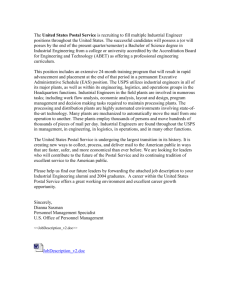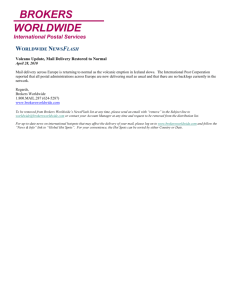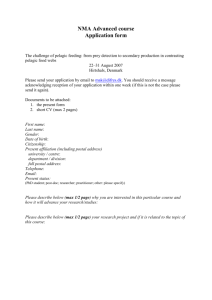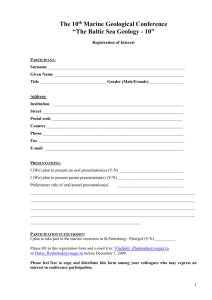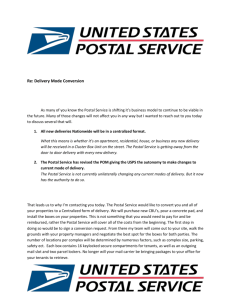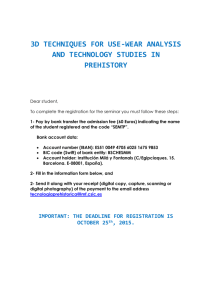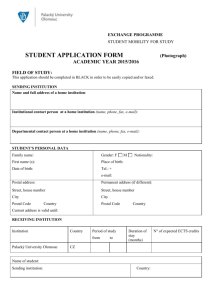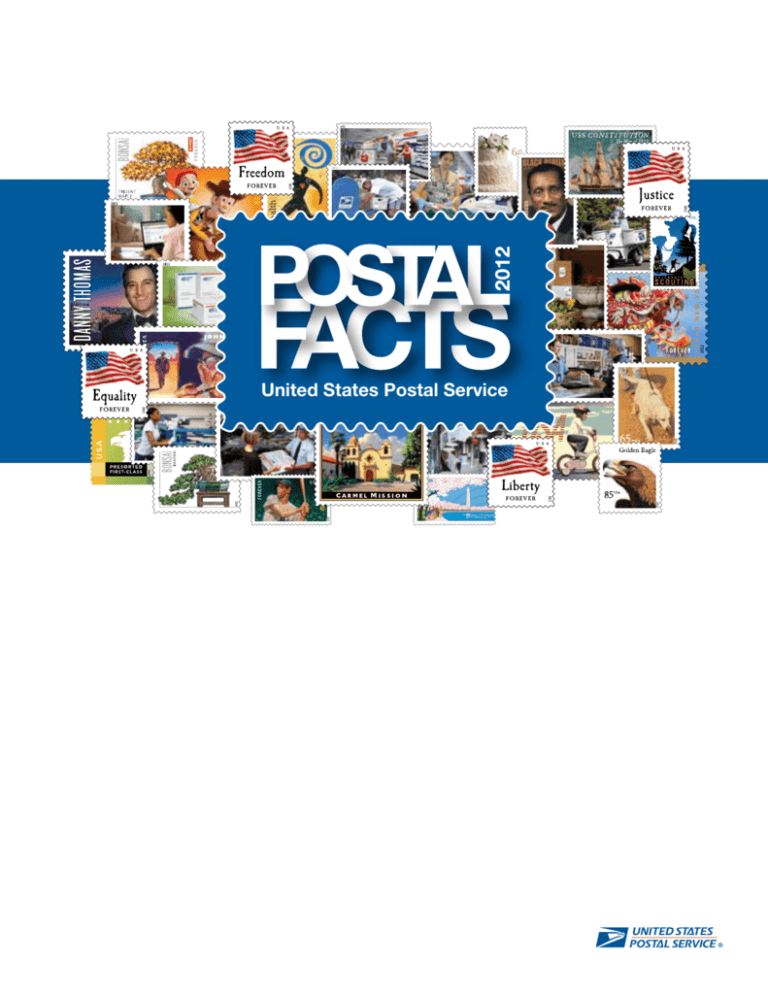
United States Postal Service
As the U.S. Postal Service continues its evolution as a forward-thinking, fast-acting
company capable of providing quality products and services for its customers,
it continues to remember and celebrate its roots as the first national network of
communications that literally bound a nation together.
Ours is a proud heritage built on a simple yet profound mission: Connect every
American, every door, every business, everywhere through the simple act of delivering
mail. This idea of universal service is at the heart of a $900 billion industry that drives
commerce, plays an integral part of every American community and remains the
greatest value of any post in the world.
This is the promise and the potential of the Postal Service and it can be found on every
page of “Postal Facts 2012.”
Size and Scope ....................................................................................................4
A Decade of Facts and Figures ........................................................................6
People, Community, Social Responsibility ................................................7
usps.com — This Post Office is Always Open ...................................................8
Quick, Easy, Convenient .................................................................................9
A Simpler Way to Ship ........................................................................................10
What the Postal Service wants you to know .............................................12
Sustainability ....................................................................................................14
Innovation and Technology ..............................................................................16
Security, Law Enforcement, Preserving the Trust .........................................18
Forensics, Crime Scenes, Evidence ................................................................19
Fun Facts .............................................................................................................20
A Day in the Life of the U.S. Postal Service — By the Numbers ..............22
The United States Postal Service delivers more mail to more addresses in a larger
geographical area than any other post in the world. The Postal Service delivers to more than
151 million homes, businesses and Post Office boxes in every state, city, town and borough
in this country. Everyone living in the U.S. and its territories has access to postal products
and services and pays the same postage regardless of their location.
By the Numbers
66 billion — revenue in 2011, in dollars
167.9 billion — number of mail pieces processed in 2011
554 million — average number of mail pieces processed each day
23 million — average number of mail pieces processed each hour
384,000 — average number of mail pieces processed each minute
6,400 — average number of mail pieces processed each second
40 — percent of the world’s mail volume handled by the Postal Service
1.9 billion — dollar amount paid every two weeks in salaries and benefits
546,000 — number of career employees
31,509 — number of Postal Service-managed retail offices
34 million — number of work hours reduced equals 19,000 full-time employees
213,881 — number of vehicles — the largest civilian fleet in the world
1.2 billion — number of miles driven each year by letter carriers and truck drivers
39.9 million — number of address changes processed in 2011
35.5 — percent of retail revenue from alternative access channels in 2011
1.2 million — number of people who visited usps.com each day
62 million — number of inquiries handled by Postal Service Contact Center in 2011
236 million — dollar amount of online stamp and retail sales at usps.com in 2011
467 million — total revenue, in dollars, from Click-N-Ship label purchases in 2011
5.6 million — number of passport applications accepted in 2011
116 million — number of money orders issued in 2011
543 million — amount in revenue from 2,500 Automated Postal Centers in 2011
71,000 — number of stores, banks and ATMs that sell postage stamps
636,530 — number of new delivery points added to the network in 2011
4
0 — tax dollars received for operating the Postal Service
Mail is Big Business
The U.S. Postal Service is the core of the trillion dollar
mailing industry that employs more than 8 million
people.*
These classes of mail brought in most of the $66
billion in revenue in 2011:
n First-Class Mail — $32.2 billion
n Advertising — $17.8 billion
n Shipping Services — $9.0 billion
n Periodicals — $1.8 billion
n Package Services — $1.6 billion
If it were a private sector company, the U.S. Postal
Service would rank 35th in the 2011 Fortune 500.
In the 2011 Global Fortune 500 list, the U.S. Postal
Service ranked 109th.
*The Envelope Manufacturers Association reported in the “2008 Economic Jobs Study
for the Mailing Industry” that there are 8.4 million jobs and over $1 trillion in revenue
attributed to the mailing industry.
5
Both literally and figuratively, the Postal Service delivers for America. Even in an
increasingly digital world, the Postal Service remains part of the bedrock infrastructure of
the American economy, serving its people and businesses, and binding the nation together.
6
2011
2010
2009
2008
2007
2006
2005
2004
2003
2002
Total Mail Volume
168 B
171 B
177 B
202.7 B
212.2 B
213.1 B
211.7 B
206.1 B
202.1 B
202.8 B
Total First-Class Mail
Volume
73.5 B
78.2 B
83.8 B
91.7 B
95.9 B
97.7 B
98.1 B
97.9 B
99.1 B
102.4 B
First-Class Stamped Mail
Volume*
25.8 B
28.9 B
31.6 B
35.4 B
42.3 B
44.4 B
45.9 B
47.7 B
49.1 B
51.9 B
Priority Mail Volume
791 M
779 M
791 M
852 M
897 M
924 M
887.5 M
848.6 M
859.6 M
998.2 M
Advertising Mail Volume
84.7 B
82.5 B
82.7 B
99.1 B
103.5 B
102.5 B
100.9 B
95.6 B
90.5 B
87.2 B
Annual Revenue
$65.7 B
$67.1 B
$68 B
$74.9 B
$74.7 B
$72.7 B
$69.9 B
$68.9 B
$68.5 B
$66.4 B
Total Career Employees
551,570
583,908
623,128
663,238
684,762
696,138
704,716
707,485
729,035
752,949
Delivery Points
151.5 M
150.7 M
150.1 M
149.2 M
148.0 M
146.2 M
144.3 M
142.5 M
141.3 M
139.4 M
Total Retail Offices
35,756
36,222
36,496
36,723
36,721
36,826
37,142
37,159
37,579
37,683
Total Postal-Managed
Retail Offices
31,509
32,528
32,662
32,741
32,695
—
—
—
—
—
Total Customer Visits
935.7 M
1.07 B
1.12 B
1.17 B
1.21 B
1.27 B
1.28 B
1.23 B
1.27 B
1.30 B
Total Retail Revenue
$12.3 B
$12.5 B
$13.1 B
$14.1 B
$14.6 B
$14.5 B
$14.9 B
$15.2 B
$15.5 B
$15.0 B
Total Delivery Routes
228,160
230,600
232,900
244,800
246,500
244,700
243,00
241,200
240,300
241,000
Total Vehicles
213,881
215,625
218,684
221,047
219,522
216,004
214,146
213,321
212,798
208,860
* Including contract postal units
The Postal Service is part of the fabric of this
nation. Postal employees make a difference in
every community across the country.
Since 1912, postal
employees, charities and
individual and corporate
volunteers help children and
families in need experience
the magic of the holiday
season by answering letters
to Santa. 2012 marks the
100th anniversary of this
program.
n Each year, postal employees around the country
risk their own safety to save the lives of the customers
they serve. In 2011, the Postal Service recognized 331
employee heroes.
n The Breast Cancer Research semi-postal stamp
has raised nearly $74 million for breast cancer research
since 1998. Sales of the stamp have been extended
until Dec. 2015.
n The fourth semi-postal — Save Vanishing Species
— was issued in 2011 to support the Multinational
Species Conservation Funds. The stamp has raised
more than $620,000 since its September issuance.
n In 2011, 20.3 billion stamps were printed — miniature works of art reflecting the American experience
and highlighting heroes, history, milestones, achievements and natural wonders.
n The Postal Service and the National Association
of Letter Carriers hold the largest one-day food drive
in the nation. In 2011, more
than 70.2 million pounds of
food were collected. Nearly
1.2 billion pounds of food have
been collected since the drive
began in 1993.
n The Postal Service,
National Marrow Donor
Program and Be the Match
Foundation created the Delivering the Gift of Life campaign 15 years ago. Nearly 57,000 postal employees
and their families have joined the donor registry.
n Working with Valassis, the National Center for
Missing and Exploited Children and the U.S. Postal
Inspection Service, the “Have You Seen Me” campaign
demonstrates the power of the mail. The campaign has
returned 151 missing children to their families (as of
Dec. 2011).
n Each year in May, the Postal Service supports
National Dog Bite Prevention Week. This public safety
campaign builds awareness concerning animal attacks.
n Postal Service employees pledge an average
of $38 million annually to the Combined Federal
Campaign.
7
The Postal Service website — usps.com — is an online Post Office at your fingertips,
and it is open for business 24/7.
8
n usps.com is one of the most frequently visited
government sites with more than 423 million visits in
2011 — averaging more than 1.2 million visitors each
day.
n In 2011, stamp and retail sales at the Postal
Store, the official online Post Office, totaled more than
$236 million.
n Click-N-Ship allows customers to print shipping
labels with postage for Priority Mail, Express Mail,
Global Express Guaranteed, Priority Mail International
and Express Mail International.
n CardStore, Premium Postcards and Click2Mail
allow customers to create and send customized
mailings from the convenience of a personal computer.
n Internet Change-of-Address allows customers to
change addresses, sign up for various services and
order moving supplies from a personal computer. More
than 12 million address changes were submitted online
in 2011.
n Customers can reserve and renew a Post Office
Box online.
n In 2011, Hold Mail Service allowed more than
10 million customers to have their mail held safely at
local Post Offices while they were away from home.
Scheduling can be done online.
n In order of popularity, the top usps.com sites in
2011:
1. Track & Confirm
2. ZIP Code Lookup
3. Calculate Postage
4. Click-N-Ship
5. Post Office Locator
Postal customers are at the center of everything the Postal Service does. With their needs
in mind, the Postal Service is making sure mail remains relevant and its products and
services are quick, easy and convenient to use.
n There’s a Post Office on your phone. Some of
the most popular functions currently available on
usps.com —Track & Confirm, Post Office Locator
and the most popular, ZIP Code Lookup — are
now available on cell phones and other mobile
devices.
n Since launching in Oct. 2009, the Postal
Service iPhone application has been repeatedly
ranked in the top 10 free business applications.
n Automated Postal Centers (APCs) provide
customers with self-service access to the most
frequently purchased postal products and services.
n In 2011, 2,500 APCs generated $543 million
in revenue through nearly 86 million transactions.
n Since the APCs launched in 2004, they have
generated more than $3.2 billion in revenue.
n The Postal Service has more than 14 million
PO Box customers.
n Redelivery Service
allows customers to
schedule the delivery
of the package they
missed.
n Going away for
a while? Take your
mailbox with you.
Premium Forwarding
Service forwards
the mail from your
permanent address to a
temporary address once
a week.
n Working with the
U.S. Department of
State, the Postal Service
accepted 5.6 million
passport applications
in 2011, generating
$182 million in revenue.
9
With 2- to 3-day delivery, free shipping supplies, flat rate options
and easy online tools, Priority Mail offers a simpler way to ship.
n If It Fits, It Ships! Priority Mail Flat Rate
boxes and envelopes eliminate the need to weigh
packages or calculate postage.
n In 2011, customers shipped more than
148 million Priority Mail Flat Rate boxes,
generating $1.4 billion in revenue — this
represents a 15 percent
revenue increase and
16 percent volume
increase since 2010.
n Click-N-Ship (CNS)
allows customers to
print shipping labels with
postage for Priority Mail,
Express Mail, Priority
Mail International, Global
Express Guaranteed and
Express Mail International.
n In 2011, more
than
10
42 million CNS labels were created in 2011,
generating $467 million in revenue.
n With Carrier Pickup, customers can go online
to request Express Mail and Priority Mail packages
be picked up at their homes or offices — for free.
n In 2011, through Carrier Pickup, more than
65 million packages were picked up at homes
and offices.
n Shipping
supplies
are free.
Priority Mail
and Express
Mail boxes,
envelopes
and labels,
international
mailing
products and
customs forms are available at no charge. They can
be ordered at usps.com or picked up at a local Post
Office.
n Unlike other shippers, the Postal Service doesn't
add surcharges for fuel, residential or Saturday delivery.
n The Postal Service is the #1 choice for eBay
shippers!
n Environmentally friendly Priority Mail Flat Rate
boxes are available at no cost at any Post Office, or can
be ordered online at shop.usps.com. Postage, labels
and customs forms can be printed online anytime using
Click-N-Ship.
n The Postal Service is the best way to ship directly
to APO and FPO locations. The Military Care Kit and
special pricing make it easier than ever before to send
care packages to loved ones stationed overseas.
n The Military Care Kit contains six Priority Mail
Flat Rate Boxes — two large and four medium — six
address labels, one roll of tape and six customs forms.
The kit can be ordered at no charge by calling 1-800610-8734.
n Priority Mail Flat Rate Boxes can
be used to ship around
the country
or around the
world. There
are seven
Priority Mail
Flat Rate Box
options to ship
to more than
190 international
destinations and
five available for
domestic use.
11
WHAT THE POSTAL SERVICE WANTS YOU TO KNOW …
For more than 235 years, the U.S. Postal Service has been delivering
the nation’s mail in snow, rain and in the dark of night. However, tough
economic and market conditions and unrealistic legislative expectations
have created challenges that have never before been faced.
The Postal
Service receives
NO tax dollars
for operating
expenses and
relies on the
sale of postage,
products and
services to fund its
operations. We are
required by law to
cover our costs.
The Postal Service
has the world’s
largest retail network
— larger than
McDonald’s, Walmart
and Starbucks
combined (in U.S.).
The Postal Service
is environmentally
friendly and is
a respected
sustainability leader.
It was promoting
sustainable practices
long before doing
so was encouraged,
mandated or
governed.
12
The Postal Service
can and does compete
with the private sector
— and it collaborates,
too. UPS and FedEx
pay the Postal Service
to deliver more than 400
million of their ground
packages to residences
and the Postal Service
pays them for air
transportation — taking
advantage of their
comprehensive air
network.
Mail is a great
communication tool. No
monthly plans. No signal
outages. No roaming
charges. Regardless
of geographic location,
anyone can send a letter
for just 45¢ anywhere in
the United States and its
territories.
… SETTING THE RECORD STRAIGHT
Misconceptions about the future of the U.S. Postal Service abound —
it’s time to set the record straight.
The Postal Service is
the only organization
in the country that has
the manpower, network
infrastructure and logistical
capability to deliver to
every residence and
business in the U.S. and
its territories.
Mail is reliable, trusted
and secure — federal
laws protecting the
sanctity of the U.S.
Mail are enforced
by the U.S. Postal
Inspection Service.
The Postal Service has
the world’s largest civilian
fleet and the world’s
largest alternative fuel –
enabled fleet of vehicles.
An independent
assessment by Oxford
Strategic Consulting
named the U.S. Postal
Service the best postal
service among the 20
largest economies in the
world. Criteria included the
average number of citizens
served, the number
of letters and parcels
delivered, service reliability
and public trust.
The Postal Service
delivered 168 billion
pieces of mail in
2011 — facilitating
$10 trillion in
commerce.
13
The mission is simple — to be a sustainability leader. The Postal Service is committed to
actions that promote sustainability — meeting the needs of the present without compromising
the future. It is working to create a culture of conservation among its more than 546,000
employees in its 32,000 facilities.
Protecting the Environment
n The Postal Service has
14
partnered with suppliers to ensure
the design and manufacturing
of its stamps, postcards, Priority
Mail and Express Mail boxes and
envelopes maximize the use of
recyclable materials.
n The Postal Service received
the EPA’s WasteWise Federal
Government Partner of the Year
award in 2010 and 2011.
n In 2011, the Postal Service
was the only agency-wide
registrant for the EPA Federal
Green Challenge.
n The Postal Service is the first
federal agency to publicly report its
greenhouse gas (GHG) emissions
and receive third-party verification
of the results.
n The Postal Service is helping
to prevent prescription drugs from
contaminating natural resources. In
2011, the Postal Service recovered
approximately 180,000 pounds of
unused pharmaceuticals through a
prescription mail-back initiative.
n Mail is delivered on bicycle
by more than 60 letter carriers
in Arizona and Florida, reducing
emissions and saving fuel.
n The Postal Service uses
three-wheeled electric delivery
vehicles — the T-3 has a 40-mile
range, a maximum speed of 12
mph, can carry 450 pounds and
averages 2 cents a mile in energy
costs.
n Two-ton electric vehicles have
been delivering mail in New York
City since 2001.
n Recycling postal-wide in FY
2011 generated about 240,000
tons of material and $24 million in
combined revenue and avoided
landfill fees.
n Almost 75,000 letter carriers
drive to a neighborhood and then
deliver the mail on foot. More than
8,000 just deliver on foot.
n More than 200,000 tons of
wastepaper, cardboard, cans,
plastics and other materials
are recycled annually through
nationwide recycling and waste
prevention programs.
n The U.S. Mail offers an easy
and efficient way to recycle items
that, if disposed of improperly,
could harm the environment.
n For more information on
Postal Service sustainability efforts,
go to usps.com/green.
Building Green
n The Postal Service National
Center for Employee Development
in Norman, OK, was recognized
by Oklahoma’s travel and tourism
board as being the greenest hotel
in the state, receiving the highest
sustainable travel certification
offered by “Encouraging
Conservation in Oklahoma.”
n The Postal Service makes
new and existing facilities more
sustainable with features like highefficiency lighting and HVAC,
recycled building materials (such as
insulation), low-water use fixtures,
solar energy systems, native plant
species in landscaping, natural day
lighting and low-volatile organic
compound materials.
n We are upgrading our
buildings to reduce energy use.
Our objective is to reduce facility
energy consumption 30 percent by
2015. We have already achieved
an over 29 percent reduction.
n The Postal Service has the
largest green roof in New York
City and one of the largest in the
country, totaling 109,000 square
feet, nearly 2.5 acres.
million square feet of space and
roughly 70 percent of the energy
consumption in the Postal Service.
n The Postal Service is
testing 10 Navistar eStar electric
step vans. This test is part of
the America Recovery and
Reinvestment Act funded
through the Department of
Energy. The new 2-ton vehicles
will be tested in three locations:
CA, NY and VA.
Conserving Energy
n The Postal Service
operates the world’s largest
fleet of alternative fuel-capable
vehicles — more than 44,000
— most are equipped to use
ethanol. There are electric,
compressed natural gas, liquid
propane gas and bio-diesel
vehicles.
n Thousands of energysaving projects have been
completed, saving an average
of 900 billion BTUs per
year. Over 1 trillion BTUs of
additional energy reductions
have been identified.
n The Postal Service
continues to use and benefit
from solar power with solar
photovoltaic systems that
convert sunlight into electricity.
n Detailed energy audits are
ongoing at our largest facilities
— representing about 150
The Postal Service is the first federal agency — and the first company in North America — to receive
the prestigious Gold Award from The Climate Registry for its sustainability efforts and leadership in reducing
greenhouse gas (GHG) emissions. Gold status is awarded to organizations that demonstrate GHG emissions
reductions of more than 5 percent.
15
From the telegraph, to the telephone, to the terabyte, the U.S. Mail has complemented every
new technology.
Information Technology
16
n We have one of the world’s largest e-mail systems.
Over 3 million e-mails a day — over 1 billion annually —
are delivered to nearly 208,000 e-mail accounts.
n The Postal Service has the world’s third-largest
computing network.
n The Postal Service maintains one of the world’s
largest intranets.
n The Postal Service has a total inventory of 957
applications with 469 classified as national applications.
Of those, 234 are considered critical to postal business
functions.
n There are 3,473 remote locations within the postal
system that receive Internet service via satellite.
n Our communications network supports and
maintains 125,000 desktop computers, 21,000
notebook computers, 85,000 printers, 11,000
Blackberrys, 152,000 phone lines and 310,857 handheld scanners.
n The Postal Service maintains 29,000 informational
pages on its Web site, usps.com.
n The Postal Service has 22 petabytes of storage
capacity — equivalent to more than 59,000 years of
songs on an MP3 player with no repeats.
n MeetingPlace hosts more than 50,000 meetings
per month.
n The Postal Service maintains 47,000 point of sale
(POS) terminals nationwide.
n 355 million internal e-mail messages and more
than 13 million external e-mail messages are scanned
for viruses every month.
n There are nearly 103,000 e-mail messages blocked
monthly due to viruses and more than 281,000 blocked
due to content.
n The Postal Service has nearly 284,000 vendors
doing $16 billion in business annually using electronic
money transfers.
n More than 340 million credit and debit card
transactions are processed annually in Post Offices and
through usps.com.
Innovative Technologies
n The Postal Service has the largest gantry
robotic fleet in the world using 174 robotics
systems to move 314,000 mail trays per day.
n The Postal Service is the world leader in
optical character recognition technology with
machines reading 93 percent of all hand-addressed
letter mail.
n The Postal Service uses more than 8,500
pieces of automated processing equipment to sort
nearly half the world’s mail.
n The Postal Service has one of the largest
material-handling systems in the world for moving
mail. There are over 200 miles of conveyors within
postal processing facilities.
n Intelligent Mail increases the value of mail for
both the Postal Service and its customers. The
Intelligent Mail barcode (IMb) identifies individual
pieces of mail, trays, sacks and containers of mail,
and tracks them through the processing system.
n The Flats Sequencing System (FSS) sorts “flat
mail” (large envelopes, magazines, etc.) in carrier
walk sequence at 16,500 pieces per hour.
n In 2011, the Postal Automated Redirection
System (PARS) automatically intercepted and
forwarded more than two billion pieces of mail for
the nearly 40 million address changes submitted.
n The Advanced Facer Canceller System (AFCS)
positions letter mail and cancels stamps at 36,000
pieces per hour.
n The Delivery Barcode Sorter (DBCS) reads the
barcode on letters and sorts them at 36,000 pieces
per hour.
n The Automated Flat Sorting Machine (AFSM)
sorts flat mail at 17,000 pieces per hour.
n The Automated Package Processing System
(APPS) processes packages and bundles of mail at
over 9,500 pieces per hour.
n The Automated Parcel and Bundle Sorter
(APBS) processes packages and bundles of mail at
over 6,000 pieces per hour.
Decoding the Code
The Zoning Improvement Plan (ZIP) Code was launched in 1963 to better handle increasing volumes of mail.
The first number in the code represents a general geographic area of the nation, “0” in the East, moving to “9”
in the West. The next two numbers represent regional areas, and the final two identify specific Post Offices.
The ZIP+4 Code was introduced in 1983. The extra four numbers allow mail to be sorted to a specific group of
streets or to a high-rise building. In 1991, two more numbers were added so that mail could be sorted directly
to a residence or business. Today, the use of ZIP Codes extends far beyond the mailing industry, and they are
a fundamental component in the nation’s 911 emergency system.
17
The U.S. Postal Inspection Service is mandated to safeguard the entire Postal Service
system — from the more than 546,000 employees who process and deliver the U.S. Mail
to the millions of customers who use it daily.
18
n One of the country’s oldest federal law
enforcement agencies, the U.S. Postal Inspection
Service has a long, proud and successful history of
protecting the Postal Service, securing the nation’s
mail system and ensuring public trust in the mail.
n Postal Inspectors arrested more than 5,500
suspects for crimes involving the mail or against
the Postal Service in 2011. About half of the arrests
involved mail theft and more than
750 involved mail-related
fraud.
n Postal Inspectors
arrested 83 suspects
in conjunction with
Operation Homeless,
which targeted mail
thieves who recruit
homeless people to
cash stolen checks.
Victim losses exceeded
$7 million.
n Postal Inspectors
are members of
the Identity Theft &
Economic Crimes Task
Force, national and state
Joint Terrorism Task Forces and
the National Center for Missing & Exploited
Children, among others. They work closely with the
financial service, airline and mail order industries to
maintain America’s confidence in the U.S. Mail.
n To quickly respond to incidents such as
natural disasters, the Postal Inspection Service has
18 mobile command centers and a mobile mailscreening station ready for action.
n Postal Inspectors deploy state-of-theart screening equipment designed to identify
hazardous substances and suspicious items in the
mail and to ensure safety at postal facilities while
keeping the mail moving.
n In 2011, Postal Inspectors responded to more
than 3,550 incidents involving suspicious items,
substances, powders or liquids in the mail or at
postal facilities. Of those incidents, 212 involved
improvised explosive devices (IEDs).
n Postal Inspectors seized $13.1 million in
proceeds related to illegal drugs from the mail
in 2011.
n Postal Inspectors participated in Operation
Due North, a multi-agency effort targeting criminal
networks specializing in telemarketing and lottery
fraud. This initiative resulted in disrupting eleven
major criminal networks operating out of Montego
Bay, Jamaica. A large amount of cash and dozens
of high-value items were seized and 14 suspects
were arrested.
n The Inspection Service participated in national
mail fraud initiatives with the Department of
Justice and the Federal Trade
Commission. The Gulf
Coast Oil Spill Fraud
Initiative focused
on fraudulent
claims related to
the Deepwater
Horizon Oil Spill.
Operation Empty
Promises focused
on business
opportunity fraud
initiatives targeting
small businesses
and work-at-home
schemes.
n Postal Inspectors
intercepted over 5 million
foreign lottery mail pieces containing counterfeit
checks totaling over $675 million.
n In 2011, Postal Inspectors seized
approximately 143,000 counterfeit postal and
non-postal money orders worth nearly $155 million
mailed to the U.S. from criminal groups.
n Postal Inspectors participated in National
Consumer Protection Week (NCPW) in March
2011, holding over 600 events nationwide. The
national theme “Your Information Destination”
highlighted consumer education resources. Over
375,000 pounds of documents were shredded for
consumers in conjunction with the NCPW event.
n Postal Inspectors, investigating those who
use the mail to sexually exploit children, identified
more victims under the age of 5 than in previous
years. In 2011, courts ordered more than $1 million
in restitution to child victims identified by Postal
Inspectors during these investigations, a 100%
increase over the previous year.
The Postal Inspection Service’s National Forensic Laboratory, composed of more than
60 highly trained forensic scientists, plays a key role in identifying, apprehending and
convicting suspects responsible for criminal offenses against the Postal Service.
n Forensic Laboratory Services provides forensic
services and technical support in the following
areas:
— Fingerprint and Automated Fingerprint
Identification System (AFIS)
— Questioned Documents and Imaging
— Physical Sciences
— Digital Evidence
n In 2011, Forensic Laboratory Services
analysts examined more than 80,000 documents,
fingerprints, controlled substances, audio, video,
digital media and other items of physical evidence.
The examinations resulted in the identification of 443
subjects, of which 94 were identified through (AFIS).
n Forensic experts testified 27 times in
various court proceedings for Inspection Service
investigations.
n In 2011, analysts identified counterfeit stamps,
altered money orders and controlled substances in
the mail.
For additional information about the U.S. Postal Inspection Service, go to postalinspectors.uspis.gov.
19
Postal Service superlatives — everything you’ve ever wanted to know …
and more.
Post Office Fun Facts
20
n Highest Elevation — Leadville, CO — 10,150 feet
above sea level
n Lowest Elevation — Mecca, CA — 180 feet below
sea level
n Westernmost in US — Wales, AK
n Easternmost in US — Lubec, ME
n Southernmost in US — Key West, FL
n Northernmost in US — Barrow, AK
n Closest to the geographical center of the 50 United
States — Belle Fourche, SD
n Closest to geographical center of the 48 contiguous
states — Lebanon, KS
n Smallest — Ochopee Main Post Office, Ochopee,
FL — 61.3 square feet
n Largest — James A. Farley Post Office, New York,
NY — 393,000 square feet
n Oldest in same building — Hinsdale, NH, since 1816
n 2nd oldest — Castine, ME, since 1833
n Coldest — North Slope of Alaska, Barrow and
Wainwright
n Hottest — Death Valley, CA
n Most Extraordinary — Peach Springs, AZ, Post Office
has walk-in freezers for food destined for delivery to the
bottom of the Grand Canyon by mule train.
n Most Isolated — Located in the farthest reaches of
northern Alaska, the Anaktuvuk Pass Post Office is the
only link to the outside world for the 300 residents who live
there. There are no roads; everything must be flown in.
n Dual Personalities — Sitting on the border between
TN and VA, the Post Office here has two different ZIP
Codes and serves customers in Bristol, TN, and Bristol, VA.
n Most Needing a Bridge — The Point Roberts, WA,
Post Office can be reached by car only by driving through
British Columbia, Canada. Only a boat or float plane can
travel directly there.
n Clinton is the most common Post Office name.
Madison is second, and Franklin and Washington are tied
for third.
n The five most common street names in the country
are Second, Third, First, Fourth and Park
n The longest Main Street in America is located in Island
Park, ID (83429) — it’s 33 miles long.
n Franklin is the most common city name with 32
namesakes around the country. Tied for second place are
Arlington, Clinton and Washington with 29 each and tied
for third place, with 28 locations each, are Madison, Salem
and Springfield.
Just the Fun Facts
n The Postal Service has one of the largest learning
management systems in the country.
n The Postal Service receives 90 percent of its
retail revenue from 10,000 of its nearly 32,000 postaloperated retail locations.
n The Postal Service prints more than 720,000
IRS W-2 forms, 3.25 million payroll checks, 1.8 million
non-payroll checks and 14.3 million payroll earnings
statements annually.
n Most Unusual Delivery Method — mule trains
in AZ. Each mule carries about 130 pounds of mail,
food, supplies and furniture down the 8-mile trail to the
Havasupai Indians at the bottom of the Grand Canyon,
averaging 41,000 pounds per week.
n Another Unusual Delivery Method — boat in MI.
The JW Westcott is a 45-foot contract mail boat out
of Detroit, MI, that delivers mail to passing ships in the
Detroit River. The JW Westcott has its own ZIP Code
— 48222.
n Another Unusual Delivery Method — dock-todock delivery on the Magnolia River in AL. A 17-foot
mail boat delivers to 180 dock-side mailboxes on a
29-mile stretch of the river.
n Located in MD, the William F. Bolger Center for
Leadership Development is a national training facility
for the Postal Service. It is the only hotel in the country
featuring an on-site Smithsonian exhibit.
n There are nearly 42,000 ZIP Codes in the country.
n The lowest ZIP Code is 00501, a unique ZIP
Code for the Internal Revenue Service in Holtsville, NY.
n The highest ZIP Code is 99950 in Ketchikan, AK.
n The easiest ZIP Code to remember is 12345, a
unique ZIP Code for General Electric in Schenectady,
NY.
n The longest rural delivery route is Route 2 in
St. Paul, KS. The carrier travels 187 miles daily and
delivers to 173 boxes.
n The shortest rural delivery route is in Veradale,
WA. The carrier travels 2 miles daily and delivers to
445 boxes.
n The Postal Service moves mail using planes,
trains, trucks, cars, boats, ferries, helicopters,
subways, float planes, hovercrafts, T-3s, street cars,
mules, bicycles and feet.
The three-wheeled electric T-3 has a 40-mile
range, a maximum speed of 12 mph, can carry
450 pounds and averages 2 cents a mile in energy
costs.
21
Each day the Postal Service picks up, processes and delivers millions of letters and packages. No
single operation in the world comes close to this level of connectivity to so many households and
businesses. Here's ONE day in the life of your United States Postal Service. (Figures are averages.)
216.9 million — revenue received, in dollars
554 million — number of mail pieces processed and delivered
242.6 million — pieces of First-Class Mail processed and delivered
279.5 million — pieces of Advertising Mail processed and delivered
159 million — dollars paid to postal employees in salaries and benefits
214,520 — number of packages picked up through Carrier Pickup
4 million — number of miles driven by letter carriers and truck drivers
8,250 — number of letter carriers who deliver mail entirely on foot — the USPS Fleet of Feet
136,964 — number of address changes processed
2,100 — number of addresses added to our delivery network
1.2 million — number of people who visit usps.com
778,877 — dollar amount of online stamp and retail sales at usps.com
1.5 million — amount of money spent on postage for Click-N-Ship labels
18,701 — number of passport applications accepted
382,256 — number of money orders issued
284,000 — number of transactions processed at 2,500 APCs
1.7 million — dollars spent at APCs
6.1 million — customers served at more than 31,000 retail locations
22
0 — tax dollars received for operating the Postal Service
A self-supporting government enterprise, the U.S. Postal
Service is the only delivery service that reaches every address
in the nation, 151 million residences, businesses and Post
Office Boxes. The Postal Service receives no tax dollars for
operating expenses, and relies on the sale of postage, products
and services to fund its operations. With nearly 32,000 retail
locations and the most frequently visited website in the federal
government, usps.com, the Postal Service has annual revenue
of more than $66 billion and delivers nearly 40 percent of the
world’s mail. If it were a private sector company, the U.S.
Postal Service would rank 35th in the 2011 Fortune 500. Black
Enterprise and Hispanic Business magazines ranked the Postal
Service as a leader in workforce diversity. The Postal Service
has been named the Most Trusted Government Agency six
consecutive years and the sixth Most Trusted Business in the
nation by the Ponemon Institute.
Trademarks
The following are among the trademarks owned by the United
States Postal Service: ACS™, APC®, Automated Postal Center®,
Carrier Pickup™, CASS™, CASS Certified™, Certified Mail™, Click-NShip®, Confirm®, Cradle to Cradle®, If it Fits, it Ships®, Customized
MarketMail®, Delivery Confirmation™, DMM®, EPM®, Express Mail®,
FAST®, FASTforward®, First-Class™, First-Class Mail®, IM™, IMb™,
Intelligent Mail®, LACSLink®, MASS™, MERLIN®, Mover’s Guide®,
NCOALink®, Netpost®, Netpost Mailing Online™, OneCode ACS®,
OneCode Confirm®, OneCode Solution®, OneCode Vision®, Parcel
Post®, Parcel Select®, PC Postage®, PLANET®, PLANET Code®, Post
Office™, PostalOne!®, Postal Service™, Postal Inspection Service®,
POSTNET™, Premium Forwarding Service® , Priority Mail®, Quick,
Easy, Convenient®, RDI™, ReadyPost®, REDRESS®, Registered
Mail™, RIBBS®, Signature Confirmation™, Simple Formulas®, Stamps
by Mail®, Standard Mail®, The Postal Store®, United States Postal
Service®, U.S. Mail®, U.S. Postal Service®, USPS®, USPS Electronic
Postmark®, USPS.COM®, usps.com®, ZIP+4®, and ZIP Code™.
This is not a comprehensive list of all Postal Service trademarks.
Mail.dat®, Mail.XML® and IDEAlliance® are trademarks owned by the
International Digital Enterprise Alliance.
Visit our newsroom online at:
http://www.usps.com/communications/newsroom/welcome.htm
or call the U.S. Postal Media Line: 202.268.2155
© 2012 United States Postal Service. All rights reserved.
National Postal Forum
The National Postal Forum is the
mailing industry’s premier educational
venue, trade show and networking event
for industry professionals. Since 1968,
it has provided business mailers with
ongoing training and education and
helped them keep pace with the mailing
industry’s rapid progress. Held once a
year in the spring, the Forum offers a
wide range of opportunities for attendees.
Currently, more than 6,000 industry
professionals attend the Forum each
year and participate in more than 100
workshops on the hottest issues facing
the mailing industry. For more information,
go to npf.org.
PASSPORT
United States
of America
The U.S. Postal Service created a simple, easy-to-understand
signage system to communicate which specific products
and services are available at any retail postal location our
customers may visit.
© 2012 United States Postal Service. All rights reserved.

